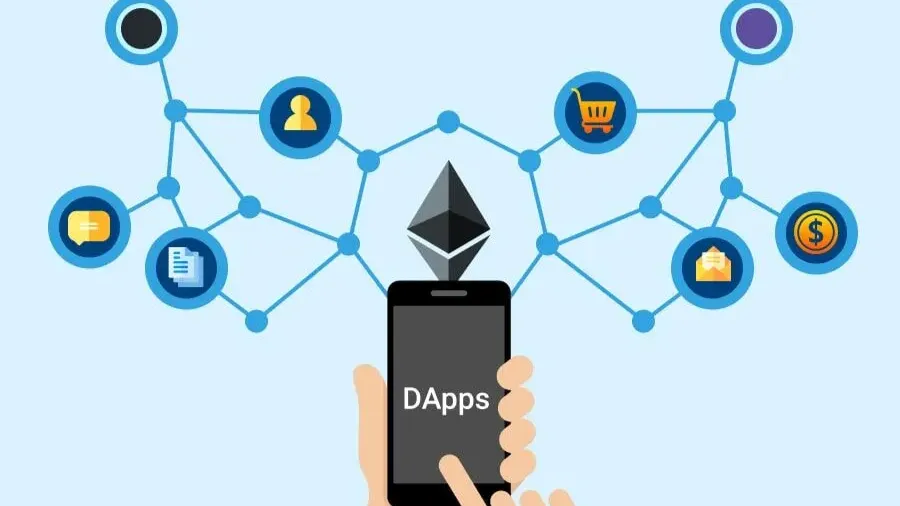Decentralized applications, or dApps, have emerged as a cornerstone of blockchain technology, reshaping industries by offering transparency, security, and user autonomy. This article explores the types of dApps, their functionality, and the steps to create one.
Types of dApps
1. Decentralized Finance (DeFi) dApps
DeFi dApps revolutionize financial services by eliminating traditional intermediaries such as banks. They allow users to lend, borrow, trade, and earn interest on their digital assets directly through smart contracts. Popular examples include platforms like Aave and Compound.
2. Decentralized Exchanges (DEXs)
DEXs enable peer-to-peer cryptocurrency trading directly from users’ wallets without a central authority. This model enhances security and eliminates reliance on third-party custody of funds. Uniswap and SushiSwap are notable examples.
3. Non-Fungible Token (NFT) dApps
NFT dApps facilitate the creation, buying, and selling of unique digital assets, such as art, music, and collectibles. Each NFT is distinct, providing proof of ownership and authenticity. Platforms like OpenSea and Rarible lead this space.
4. Decentralized Autonomous Organizations (DAOs)
DAOs are blockchain-based organizations governed by smart contracts and community voting mechanisms. They promote transparent decision-making and decentralized governance. Examples include MakerDAO and Aragon.
5. Decentralized Marketplaces
These dApps connect buyers and sellers directly, leveraging blockchain for transparent transactions. They eliminate intermediaries and are often used for goods, services, or even digital assets. A popular example is Origin Protocol.
6. Decentralized Identity Solutions
Identity-focused dApps offer secure, user-controlled identity management. Users can authenticate themselves and manage their data without relying on centralized entities. Examples include Civic and uPort.
7. Decentralized Storage Solutions
Decentralized storage dApps provide distributed data storage systems, enhancing security, redundancy, and resistance to censorship. Solutions like Filecoin and Storj are prominent.
8. Gaming dApps
Gaming dApps utilize blockchain to create decentralized games, allowing players to own in-game assets, trade them, and engage in gaming economies. Titles like Axie Infinity and Gods Unchained have gained significant traction.
How dApps Work
The operation of dApps is powered by blockchain technology, ensuring security and transparency. Here’s a step-by-step breakdown of a typical dApp transaction:
- Initiate Transaction Users interact with the dApp’s interface (web or mobile app) to initiate an action like transferring tokens or participating in governance.
- Sign Transaction The dApp requests the user’s digital wallet (e.g., MetaMask) to sign the transaction. This step verifies the user’s identity and authorizes the action.
- Smart Contract Execution The signed transaction is sent to the blockchain, where a smart contract processes it. Smart contracts perform predefined actions such as updating balances or recording votes.
- Blockchain Validation The transaction is broadcast to the blockchain network, validated by nodes, and added to a new block. This ensures immutability and transparency.
- Transaction Confirmation Once confirmed, the blockchain records the transaction permanently, and the dApp updates its interface to reflect the new state.
dApp Development Process
Creating a dApp involves multiple stages, each crucial to ensuring functionality, security, and user adoption. Below is an overview of the development process:
1. Design and Planning
- Define the purpose of the dApp and the problem it addresses.
- Outline key features and choose a suitable blockchain platform (e.g., Ethereum, Solana).
- Design the architecture, including smart contracts, frontend, and optional backend services.
2. Smart Contract Development
- Write smart contracts in blockchain-specific programming languages like Solidity for Ethereum.
- Test contracts extensively on test networks (e.g., Ropsten) to identify bugs before mainnet deployment.
3. Frontend and Backend Development
- Build a user-friendly interface using technologies like React, Vue.js, or Angular.
- Develop backend services for off-chain functionalities, such as data storage or API integration.
4. Integration
- Connect the dApp to digital wallets for user authentication and transaction handling.
- Use libraries like Web3.js or ethers.js for seamless communication with the blockchain.
5. Testing
- Conduct rigorous testing, including unit, integration, and end-to-end testing.
- Perform security audits, preferably with third-party firms, to ensure the safety of smart contracts.
6. Deployment
- Deploy smart contracts to the main blockchain network.
- Host the frontend application on platforms like IPFS or traditional web servers.
7. Maintenance and Upgrades
- Monitor performance and user feedback to implement improvements.
- Handle smart contract upgrades cautiously to maintain data integrity.
8. Community Engagement and Governance
- Build a strong user community through forums, social media, and support channels.
- Participate in governance processes, allowing users to shape the dApp’s future.
dApps represent a paradigm shift in how we interact with technology, offering decentralized alternatives to traditional systems. From DeFi and gaming to identity management, their potential spans across industries. With a clear understanding of their types, functionality, and development process, businesses and developers can leverage dApps to create innovative, user-centric solutions in the blockchain ecosystem.
~Rushen Wickramaratne


